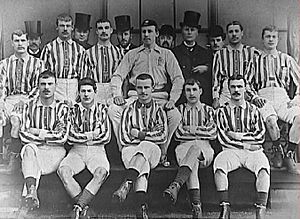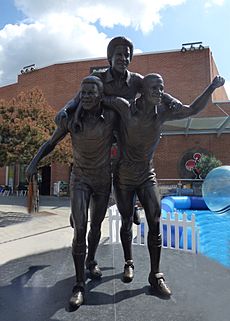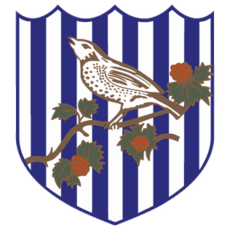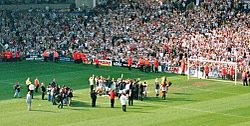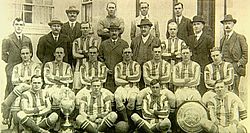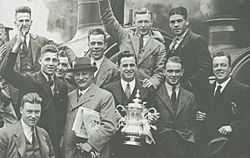West Bromwich Albion F.C. facts for kids
 |
|||
| Full name | West Bromwich Albion Football Club | ||
|---|---|---|---|
| Nickname(s) |
|
||
| Short name |
|
||
| Founded | 1878 | ||
| Ground | The Hawthorns | ||
| Capacity | 26,850 | ||
| Owner | Bilkul Football WBA | ||
| Chairman | Shilen Patel | ||
| Head coach | Ryan Mason | ||
| League | Championship | ||
| 2018–19 | Championship, 4th of 24 | ||
|
|
|||
West Bromwich Albion Football Club, often called West Brom or The Albion, is a professional association football team from West Bromwich, England. They play in the EFL Championship, which is the second-highest league in English football. The club started in 1878 and has played at its home stadium, The Hawthorns, since 1900.
Albion was one of the first teams to join the Football League in 1888. This was the world's first professional football league. The club has spent most of its history in the top league of English football, playing there for 82 seasons. They were last in the Premier League in 2021.
West Bromwich Albion has won the English league title once, in 1919–20. They have also been runners-up twice. The team has reached the FA Cup final ten times and won it five times. Their first FA Cup win was in 1888, and their most recent was in 1968. This was the club's last major trophy. Albion also won the Football League Cup in 1966.
The team usually plays in navy blue and white striped shirts. Their club badge shows a throstle (a type of bird) sitting on a hawthorn branch. West Brom has long-standing rivalries with local teams Aston Villa and Wolverhampton Wanderers. Their matches against Wolverhampton Wanderers are known as the Black Country derby.
Contents
Club History: From Strollers to Champions
Early Days and First Trophies (1878–1950)
The club began in 1878 as West Bromwich Strollers. It was started by workers from a spring factory in West Bromwich. In 1880, they changed their name to West Bromwich Albion. The "Albion" part came from a local area where some players lived.
In 1883, Albion won their first trophy, the Staffordshire Cup. They joined the Football Association the same year, which meant they could play in the FA Cup. After reaching the FA Cup final twice and losing, they finally won it in 1888. They beat Preston North End 2–1.
In March 1888, Albion became one of the twelve founding members of the Football League. This was a new idea for clubs to play each other regularly. Albion won the FA Cup again in 1892. They won the Football League title in 1919–20, which is their only league title ever. In 1930–31, they achieved something special: they won both promotion to the top league and the FA Cup in the same season! This "double" has not been done since.
Years of Success and Challenges (1950–1992)
In 1953–54, Albion almost won both the league and the FA Cup. They won the FA Cup but finished second in the league to their rivals, Wolverhampton Wanderers. This team was known for its exciting, attacking football and was even called the "Team of the Century."
In the 1960s, West Brom became known as a strong cup team. They won the Football League Cup in 1966. The next year, they reached the final again but lost. In 1968, they won their last major trophy, the FA Cup, beating Everton in extra time.
In the late 1970s, the team was famous for having three black players: Cyrille Regis, Laurie Cunningham, and Brendon Batson. They were known as "the Three Degrees" and helped make black footballers more accepted in English football. After a period of success, the club faced a tough time and was relegated from the top league in 1986. Five years later, they even dropped to the third division for the first time.
Recent Journeys (1992–Present)
When the Premier League started in 1992, Albion was in the third division. They earned promotion back to the second level in 1993 by winning the play-offs at Wembley.
Under manager Gary Megson, Albion returned to the Premier League in 2002. After being relegated, they came straight back up in 2004. In 2005, under former player Bryan Robson, the team achieved a "Great Escape." They were at the bottom of the league on the final day but managed to avoid relegation, which was a first for a Premier League club!
Albion was promoted to the Premier League again in 2008 as champions of the Championship. They were relegated in 2009 but returned quickly in 2010 under Roberto Di Matteo. The club then had an eight-season run in the Premier League, finishing as high as 8th place.
In 2016, a Chinese investment group led by Guochuan Lai bought the club. After being relegated in 2018, Albion returned to the Premier League in 2020 under manager Slaven Bilić. However, they were relegated again in 2021.
In February 2024, American businessman Shilen Patel and his father bought a majority stake in the club. As of July 2025, West Bromwich Albion continues to compete in the EFL Championship.
Club Badge and Team Colours
The Club Badge: A Throstle's Tale
Albion's main club badge has been around since the late 1880s. It features a throstle (a type of bird) sitting on a hawthorn branch. The throstle was chosen because the pub where the team used to change had a pet thrush in a cage. This also gave the team an early nickname: the Throstles. The hawthorn branch was added after the club moved to The Hawthorns stadium, which was named after hawthorn bushes.
In the past, a real caged throstle was sometimes placed by the field during matches. People said it would only sing if Albion was winning! Today, a large model of a throstle sits above the scoreboard at The Hawthorns. The club's badge was updated in 2006 to include the club's name.
Team Colours: Blue and White Stripes
|
|
| Albion's strip from 1882 to 1883 was one of many variations worn during the 1880s. |
|
|
| Albion's common away colours in the late 20th and early 21st century. |
West Brom has mostly played in navy blue and white striped shirts, usually with white shorts and socks. Fans sometimes call the team the Stripes. In the very early days, the team tried different colours, but the blue and white stripes first appeared in 1885–86.
Like all football clubs, Albion has a second "away" kit for games when their home colours clash with the other team's. In the past, they used white jerseys with black shorts. Since the 1960s, the away kit has changed often, with yellow and green stripes being a common choice. Sometimes, a third kit is also used.
Players started wearing numbers on their shirts in 1939–40 and names on their shirts from 1999–2000.
Kit Sponsors and Manufacturers
BSR Housewares was the club's first shirt sponsor in 1981–82. The club has had many sponsors since then. The longest sponsorship deal was with the West Bromwich Building Society, which lasted seven seasons. Today, the main sponsor is Ideal Heating.
Since June 2024, Macron has made West Brom's kits. Before that, companies like Umbro, Adidas, and Puma made them.
| Period | Kit manufacturer | Shirt sponsor |
|---|---|---|
| 1974–1981 | Umbro | — |
| 1981–1982 | BSR | |
| 1982–1984 | Swan | |
| 1984–1986 | No Smoking | |
| 1986–1989 | Apollo/Apollo 2000 | |
| 1989–1990 | Scoreline | |
| 1990–1991 | Sandwell Council | |
| 1991–1992 | Influence | |
| 1992–1993 | Albion Collection | |
| 1993–1994 | Pelada | Coucher & Shaw |
| 1994–1995 | Guest Motors | |
| 1995–1997 | Patrick | |
| 1997–2002 | West Bromwich Building Society | |
| 2002–2003 | The Baggies | |
| 2003–2004 | Diadora | |
| 2004–2006 | T-Mobile | |
| 2006–2008 | Umbro | |
| 2008–2009 | — | |
| 2009–2010 | — | |
| 2010–2011 | HomeServe | |
| 2011–2012 | Adidas | bodog |
| 2012–2014 | Zoopla | |
| 2014–2015 | QuickBooks | |
| 2015–2016 | TLCBET | |
| 2016–2017 | K8 | |
| 2017–2018 | Palm Eco-Town Development | |
| 2018–2024 | Puma | Ideal Heating (Groupe Atlantic) |
| 2024– | Macron |
The Hawthorns: Albion's Home Stadium

West Bromwich Albion moved grounds four times in its first seven years because the club grew so fast. Their first home was Cooper's Hill in 1878. They later played at Bunn's Field and the Four Acres. From 1885 to 1900, they played at Stoney Lane, where they won the FA Cup twice.
In 1900, the club needed an even bigger stadium and moved to its current home, The Hawthorns. It was named after the hawthorn bushes that grew there. The first game at The Hawthorns was on September 3, 1900. The record number of fans at the stadium was 64,815 in 1937.
The Hawthorns became an all-seater stadium in the 1990s. Today, it can hold 26,688 fans. It is the highest football ground among the top 92 English clubs, sitting 551 feet (168 meters) above sea level.
The stadium's West Stand could be made bigger to hold around 30,000 people. West Bromwich Albion also owns shops and the former Hawthorns Pub near the stadium. This pub is now a fanzone with live music and activities for families.
Albion Supporters: The Baggies' Spirit
Fan Culture and Traditions
The official West Bromwich Albion Supporters Club started in 1951. There are now many branches of the club around the world. There are also special groups for fans with disabilities, for mental health support, and for different communities.
Albion's "club anthem" is The Lord's my Shepherd, a song based on a psalm. Fans started singing it in the 1970s. When the team scores a goal, supporters jump up and down and chant "Boing Boing!" This chant started in the 1992–93 season. The instrumental song The Liquidator is also played and sung at the stadium.
In 2002–03, Albion's fans were voted the best in the Premier League by other clubs' supporters.
Many famous people are West Brom fans, including comedians Frank Skinner and Lenny Henry, TV presenters Adrian Chiles and Cat Deeley, and musician Eric Clapton.
The "Baggies" Nickname
While the club was first known as "the Throstles", the more popular nickname became the Baggies. This name was first heard at The Hawthorns in the early 1900s. One idea is that rival fans from Aston Villa called them "Baggies" because many Albion fans wore loose-fitting trousers for work in local factories. Another idea is that it came from the "bagmen" who carried the club's money from the turnstiles in large leather bags.
The club's official mascots are Baggie Bird and Albi, both based on the throstle bird from the club crest.
Club Rivalries
The Black Country Derby
Albion and Wolverhampton Wanderers play in the Black Country derby, which is one of the oldest and most intense rivalries in English football. A survey in 2008 found it to be the most intense rivalry in the country. The two teams have played each other 160 times. Both clubs were founding members of the Football League in 1888, making their derby one of the oldest in league history.
The rivalry became even stronger in the 1990s when both clubs were in the same division. In 2002, Albion managed to overtake Wolves to win promotion, which added to the rivalry. In February 2012, West Brom beat Wolves 5–1 away from home in a game known as the 'demolition derby'.
Rivalry with Aston Villa
Games between Aston Villa and West Brom are also very competitive. They first played each other in 1882. The two teams met in three FA Cup finals in the late 1800s.
For many years, Albion and Villa were not in the same league, but the rivalry has grown stronger again recently. In the 2018–19 play-offs, Villa beat Albion on penalties in a very close match.
Club Leadership
As of 1 September 2024
Board of Directors
| Position | Name |
|---|---|
| Majority Shareholder and Chairman | Shilen Patel |
| Managing Director | Mark Miles |
Senior Management Team
| Position | Name |
|---|---|
| Sporting Director | Andrew Nestor |
| Director of Medical | Tony Strudwick |
| Head of Football Operations | Ian Pearce |
| Director of Communications | Ian Skidmore |
| Academy Manager | Richard Stevens |
History of Ownership
In the early days, West Bromwich Albion was run by a committee of players. The first chairman was Henry Jackson in 1885. The club became a company in 1891. Many early chairmen, like Billy Bassett, had also played for the club. Bassett was the longest-serving chairman, from 1908 until his death in 1937. He helped save the club from financial trouble more than once.
In 1996, the club allowed supporters to buy shares. In 2004, it became a private company again. Jeremy Peace became chairman in 2002. In 2016, he sold the club to a Chinese investment group led by Lai Guochuan.
In February 2024, Shilen Patel, an American businessman, and his father, Kiran C Patel, bought an 87.8% share in the club. Shilen Patel became the new chairman.
Players and Coaching Staff
Current First Team Squad
|
|
Coaching Staff
As of 1 June 2025
First Team Coaches
|
Academy Coaches
|
Famous Players and Club Records
Notable Former Players
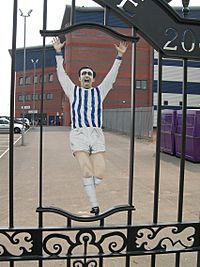

In 2004, for the club's 125th anniversary, fans voted for the greatest West Brom players of all time. A special group of 16 players was chosen. Most of them were English, but one, Cyrille Regis, was born in French Guiana and played for England. These players are shown on a mural at The Hawthorns.
Some of the most famous players include:
| Name | Nat. | Years | Apps | Goals | Position |
|---|---|---|---|---|---|
| Billy Bassett | 1886–99 | 311 | 77 | Outside right | |
| Jesse Pennington | 1903–22 | 496 | 0 | Left back | |
| W. G. Richardson | 1929–45 | 354 | 228 | Centre forward | |
| Ray Barlow | 1944–60 | 482 | 48 | Left-half | |
| Ronnie Allen | 1950–61 | 458 | 234 | Centre forward | |
| Don Howe | 1952–64 | 379 | 19 | Right back | |
| Derek Kevan | 1953–63 | 262 | 157 | Centre forward | |
| Tony Brown | 1963–81 | 720 | 279 | Wing half/Inside forward | |
| Jeff Astle | 1964–74 | 361 | 174 | Centre forward | |
| John Osborne | 1967–72 1973–78 |
312 | 0 | Goalkeeper | |
| John Wile | 1970–83 | 619 | 29 | Centre-half | |
| Willie Johnston | 1972–79 | 261 | 28 | Outside left | |
| Bryan Robson | 1974–81 | 249 | 46 | Central midfielder | |
| Derek Statham | 1976–87 | 373 | 11 | Left back | |
| Laurie Cunningham | 1977–79 | 114 | 30 | Winger | |
| Cyrille Regis | 1977–84 | 302 | 112 | Centre forward |
Tony Brown holds many club records. He has played the most games for Albion (720) and scored the most goals (279). Jesse Pennington has played for England the most times while being an Albion player, with 25 appearances.
Player of the Year Awards
|
|
|
|
Club Records
West Bromwich Albion's biggest win was 12–0 against Darwen in 1892. This is still the largest winning margin in English top-flight football. Their biggest FA Cup win was 10–1 against Chatham in 1889.
Tony Brown holds the record for most appearances (720 games) and most goals (279 goals) for the club. The highest amount of money Albion has paid for a player was £15 million for Oliver Burke in 2017. The most money they have received for a player was £16.5 million for Salomón Rondón in 2019.
Club Achievements
League Titles
- First Division (Top League)
- Champions: 1919–20
- Runners-up: 1924–25, 1953–54
- Second Division / First Division / Championship (Second League)
- Champions: 1901–02, 1910–11, 2007–08
- Runners-up: 1930–31, 1948–49, 2001–02, 2003–04, 2009–10, 2019–20
- Second Division (Third League)
- Play-off winners: 1993
Cup Wins
- FA Cup
- Winners: 1887–88, 1891–92, 1930–31, 1953–54, 1967–68
- Runners-up: 1885–86, 1886–87, 1894–95, 1911–12, 1934–35
- Football League Cup
- Winners: 1965–66
- Runners-up: 1966–67, 1969–70
- FA Charity Shield
- Winners: 1920, 1954 (shared)
- Runners-up: 1931, 1968
- Tennent Caledonian Cup
- Winners: 1977
See also
 In Spanish: West Bromwich Albion Football Club para niños
In Spanish: West Bromwich Albion Football Club para niños



